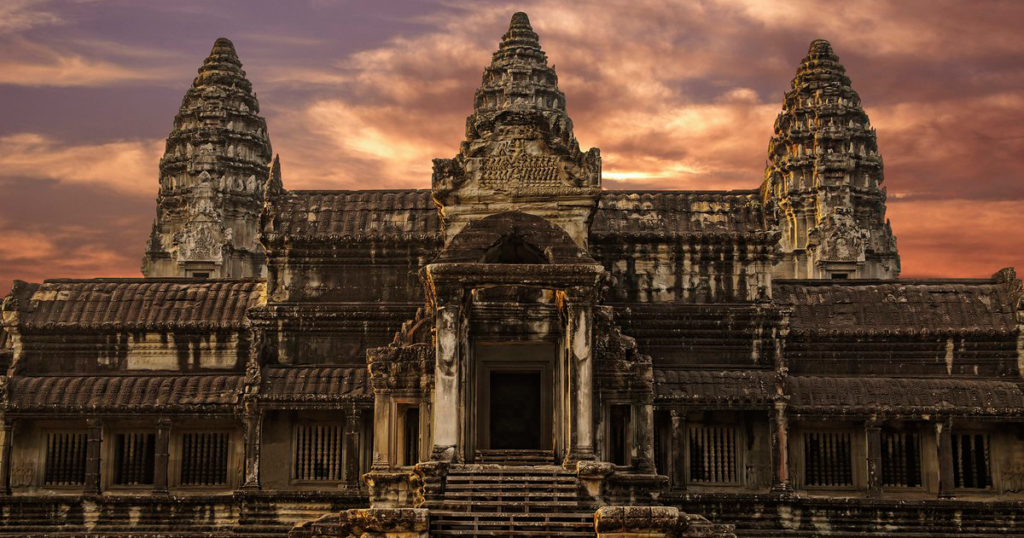Introduction to Angkor Wat
Angkor Wat, a UNESCO World Heritage Site, stands as one of Cambodia’s most iconic landmarks. It represents a magnificent achievement in ancient architecture, cultural history, and religious significance. Built in the early twelfth century, it was initially a Hindu temple dedicated to Vishnu. Over time, it transitioned to a Buddhist site, reflecting the changing religious landscape of the region. Today, Angkor Wat remains the largest religious monument in the world, attracting millions of visitors each year.
The Architectural Marvel of Angkor Wat
Angkor Wat spans over four hundred acres, with its design symbolizing Mount Meru, the center of the universe in both Hinduism and Buddhism. The central tower reaches a height of about sixty meters, representing the peak of Mount Meru. Surrounding this central structure are walls and a moat that mimic the mountain ranges and oceans, showcasing the temple’s immense scale and its spiritual significance.
Visitors marvel at the intricate bas-reliefs that adorn the temple, telling stories from Hindu mythology. One of the most famous scenes is the Churning of the Ocean of Milk, an important narrative in Hindu tradition. These carvings not only reflect the artistic mastery of the Khmer civilization but also provide insights into its beliefs and cultural values.

The Historical Significance of Angkor Wat
Angkor Wat was constructed during the reign of King Suryavarman II, whose empire flourished during the twelfth century. The temple served not only as a state temple but also as a political and religious center for the Khmer Empire. Over time, as the empire declined and the capital was abandoned, Angkor Wat remained a vital spiritual site.
It is remarkable that despite the empire’s downfall, Angkor Wat continued to be maintained by Buddhist monks. This dedication allowed the temple to survive centuries of turmoil and remain an important pilgrimage site. The temple’s ability to endure reflects the resilience and importance of the Khmer civilization.
Visiting Angkor Wat Today
Located just a few kilometers north of Siem Reap, Angkor Wat is part of the Angkor Archaeological Park. The park is open to visitors every day, with the temple itself accessible from early morning until late afternoon. Most tourists choose to visit during the dry season, which spans from November to May. This time offers the best weather for exploring the temple complex and other nearby ruins.
The official Angkor Pass can be purchased at the ticket center in Siem Reap. This pass grants access to the Angkor Archaeological Park and allows visitors to explore not only Angkor Wat but also other significant temples in the area. The entrance fees can be paid in cash or by credit card, making it convenient for international travelers.
Preservation Efforts and Global Recognition
In recognition of its cultural importance, Angkor Wat was designated as a UNESCO World Heritage Site in the early nineties. UNESCO’s efforts to preserve and protect the site are vital in maintaining its integrity and ensuring it remains a key part of Cambodia’s heritage. The ongoing preservation projects focus on stabilizing the temple’s structure, restoring damaged sections, and safeguarding the surrounding environment.
The significance of Angkor Wat goes beyond its historical and architectural beauty. As a symbol of Cambodian identity, it plays a crucial role in the country’s cultural and national pride.
Conclusion
Angkor Wat stands as an awe-inspiring testament to the ingenuity and devotion of the Khmer civilization. Its vast scale, architectural complexity, and rich history make it one of the most remarkable landmarks in the world. Today, it continues to captivate visitors from all corners of the globe, offering a unique window into the past and a glimpse of the enduring legacy of the Khmer Empire.
